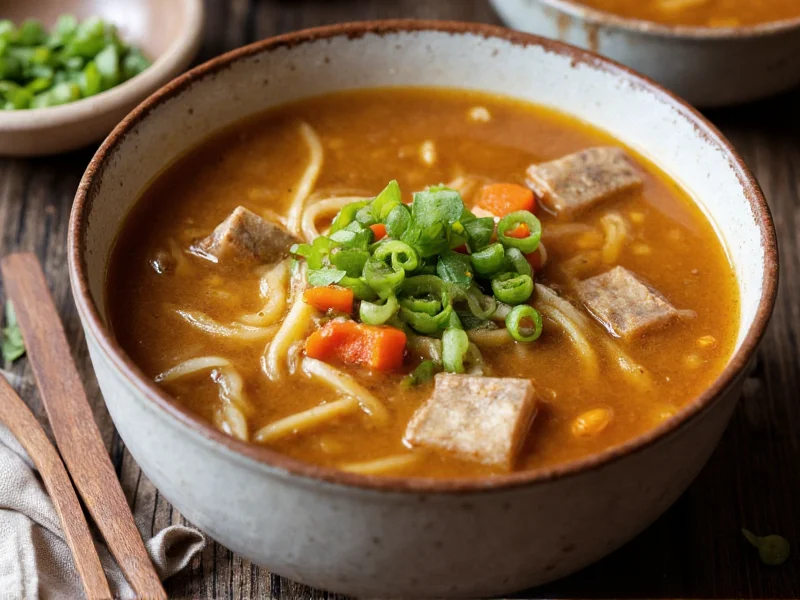Understanding whether miso soup fits within a vegan diet requires examining both the miso paste itself and the broth it's dissolved into. While the fermented soybean paste at the heart of miso soup is generally plant-based, the traditional Japanese preparation frequently includes animal products that many vegans avoid.
Breaking Down Miso Paste Ingredients
Miso paste forms the foundation of miso soup and is typically vegan-friendly. Standard miso production involves:
- Fermented soybeans (or sometimes other grains like rice or barley)
- Sea salt
- Koji (Aspergillus oryzae fungus culture)
This basic formulation contains no animal products. However, some specialty miso varieties might include non-vegan additives, so checking labels remains important for strict vegans.
Why Traditional Miso Soup Isn't Always Vegan
The primary non-vegan component in many miso soup preparations is the dashi broth. Traditional Japanese dashi contains:
| Broth Type | Typical Ingredients | Vegan Status |
|---|---|---|
| Ichiban Dashi (First Broth) | Bonito flakes (dried, fermented tuna), kombu | Non-vegan |
| Nibon Dashi (Second Broth) | Used bonito flakes, additional kombu | Non-vegan |
| Shiitake Dashi | Dried shiitake mushrooms, kombu | Vegan |
| Kombu Dashi | Kelp (kombu) only | Vegan |
Bonito flakes (katsuobushi), made from fermented, smoked, and dried skipjack tuna, are the most common non-vegan ingredient in traditional miso soup. Many restaurants and pre-made miso soup products use this fish-based dashi as their base.
Identifying Vegan Miso Soup Options
When determining if miso soup is vegan, consider these factors:
Reading Miso Paste Labels
While most miso pastes are vegan, check for:
- Added bonito or fish extracts (rare but possible in some specialty misos)
- Non-vegan preservatives or additives
- "Hon-mirin" (contains alcohol derived from rice fermentation but sometimes includes non-vegan additives)
Restaurant Ordering Tips
When dining out, ask specifically:
- "Is your dashi broth made with bonito flakes or fish products?"
- "Can you prepare miso soup with kombu-only dashi?"
- "Does your miso soup contain any animal-derived ingredients?"
Creating Authentic Vegan Miso Soup at Home
Making genuinely vegan miso soup requires attention to both the dashi and miso components. Here's a simple preparation method that maintains traditional flavor while remaining plant-based:
Vegan Miso Soup Recipe
Ingredients:
- 4 cups water
- 10g dried kombu (kelp)
- 15g dried shiitake mushrooms
- 3-4 tablespoons vegan miso paste (white or yellow)
- 1/2 block silken tofu, cubed
- 2 green onions, thinly sliced
- Optional: wakame seaweed
Instructions:
- Soak kombu and shiitake in cold water for 30 minutes (or overnight in refrigerator for deeper flavor)
- Gently heat to 160°F (70°C), just below boiling point
- Remove kombu before water reaches full boil
- Strain out shiitake mushrooms
- Reduce heat to low and whisk in miso paste (never boil miso as it kills beneficial probiotics)
- Add tofu, wakame (if using), and green onions
- Serve immediately
Store-Bought Miso Soup Considerations
Many instant miso soup packets contain fish-derived ingredients. When purchasing pre-made miso soup:
- Look for explicit "vegan" labeling
- Check for "bonito," "katsuobushi," "fish," or "seafood" in ingredients
- Beware of "natural flavors" which may contain animal products
- Choose products with simple, recognizable ingredients
Brands like Hikari Miso, Eden Foods, and Namikura offer explicitly vegan miso products, but always verify current formulations as recipes can change.
Understanding Regional Variations
Miso soup preparation varies across Japan, affecting vegan suitability:
- Kanto region (Tokyo area): Typically uses red miso with stronger, saltier flavor and often contains fish-based dashi
- Kansai region (Osaka area): Prefers white miso with milder flavor; slightly higher chance of vegetarian preparation but still often contains fish
- Ryukyu Islands: Some variations may include non-traditional ingredients that could be non-vegan
When traveling in Japan or eating at Japanese restaurants, don't assume miso soup is vegetarian unless specifically confirmed.
Health Benefits of Vegan Miso Soup
Properly prepared vegan miso soup offers numerous health benefits that align with plant-based nutrition principles:
- Rich in probiotics from fermented soybeans
- Contains essential minerals from seaweed and kelp
- Provides complete plant protein when combined with tofu
- Low in calories but high in satiety
- Supports gut health through fermentation
The fermentation process in miso creates beneficial enzymes and increases bioavailability of nutrients, making vegan miso soup not just ethically sound but nutritionally valuable for plant-based diets.
Navigating Cultural Context
When discussing vegan miso soup, it's important to acknowledge the cultural significance of this traditional Japanese food. Traditional preparation includes fish products not out of disregard for dietary restrictions, but as part of centuries-old culinary practices. Creating vegan versions respects both cultural heritage and personal dietary choices when done thoughtfully.
Frequently Asked Questions
Is miso paste always vegan?
Most miso paste is vegan, made from fermented soybeans, salt, and koji. However, some specialty misos may contain non-vegan additives, so checking labels is recommended for strict vegans.
Why is traditional miso soup not vegan?
Traditional miso soup uses dashi broth made with bonito flakes (dried, fermented tuna), which makes it non-vegan. The miso paste itself is typically vegan, but the broth preparation determines whether the complete soup is vegan-friendly.
Can I find vegan miso soup at Japanese restaurants?
Some Japanese restaurants offer vegan miso soup upon request, but it's not standard. Always ask specifically if they can prepare miso soup with kombu-only dashi instead of fish-based broth. Many traditional establishments may not routinely offer this option.
What's the best vegan substitute for traditional dashi in miso soup?
The best vegan substitutes for traditional dashi are kombu (kelp) dashi or shiitake mushroom dashi. Combining both creates a rich umami flavor that closely mimics traditional dashi without any animal products.
Does boiling miso paste affect its vegan status?
Boiling miso paste doesn't change its vegan status, but it does destroy beneficial probiotics and alters the flavor. For best results, add miso paste to broth after removing from heat (around 160°F/70°C) to preserve both nutritional benefits and traditional flavor profile.











 浙公网安备
33010002000092号
浙公网安备
33010002000092号 浙B2-20120091-4
浙B2-20120091-4